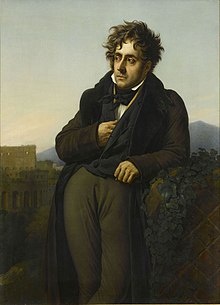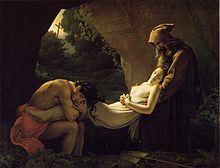Anne-Louis Girodet Trioson
Anne-Louis Girodet-Trioson (born January 5, 1767 in Montargis ( Département Loiret ), † December 9, 1824 in Paris ; actually Anne-Louis Girodet de Roussy-Trioson or Roucy-Trioson ) was a French history and portrait painter at the Threshold from classicism to romanticism , illustrator of classic literary works and poets.
Life
Born and raised in a middle-class family in Montargis - his father was the administrator of the estate of the Duke of Orléans - Anne-Louis Girodet was sent to Paris at the age of seven, where he was cared for by family friend Benoît François Trioson (1736-1816) Receive training in Latin, Rhetoric, Philosophy, Science, Music and Dance. In the course of this classical training he showed a literary and artistic talent at an early age and enrolled at the Académie royale de peinture et de sculpture as a student of Nicolas-René Jollain in 1783 , eight months later, on the recommendation of Joseph Vernet, additionally in the class of Étienne-Louis Boullée at the Académie royale d'architecture. From January 1784 on Boullée's advice, Girodet took drawing lessons from the respected history painter Jacques-Louis David , in whose studio he started as a pupil at the end of 1784 at the age of 17. His father had died only a few months earlier, and his mother also died in 1787.
The stimulating, competitive atmosphere in David's studio prompted Girodet early on to measure himself against his teacher and to rub artistically. As one of David's best students, Girodet-Trioson took part in the competition for the Prix de Rome as early as 1786 , in which, after three fruitless attempts (1786, 1787, 1788) , he was recognized by his brothers in 1789 for his painting Joseph, on the occasion of the Paris Salon was awarded the gold medal. Associated with this was a scholarship from the king and a study visit to Rome , where the Académie de France à Rome was then housed in the Palazzo Mancini. Girodet, who liked to display a bourgeois artist rebelliousness, did not leave immediately, however, but stayed in Paris during the revolutionary events of the summer of 1789.
In March 1790 Girodet finally set out on a six-week journey to Rome, where he arrived on May 30, 1790. He spent almost five years in Italy. During this time he began to distance himself openly from the classical style of his teacher David, for which his poetic academy piece The Sleeping Endymion is often cited as an example. The meetings in Rome that were important for his career included those with the architects Charles Percier and Pierre-François-Léonard Fontaine , who later favored him with commissions. When the academy building was stormed and looted on January 13, 1793 by a crowd indignant about the events of the French Revolution , the scholars fled Rome. Girodet ended up with a friend, the landscape painter Jean-Pierre Péquignot (1765–1807), first to Naples. There the penniless artist fell seriously ill with syphilis , so that he was only able to leave the city more than a year later, in June 1794. In the autumn of 1795, after stops in Venice and Florence, he returned to his family in Montargis.
He settled as a freelance artist in Paris, but as an artist he could not inspire much in the years after the revolution: he financed his life primarily with portraiture. One of his most important students in those years was Achille Devéria . Also studied Marie-Denise Villers and a dozen other students with him. At the anniversary exhibition of the Paris Salon in 1810, his painting The Deluge was awarded a gold medal. With this work, which was created in 1806, he was finally able to outdo his teacher David, whose robbery of the Sabine women was only mentioned with praise. However, there was no purchase. It was only at the Salon of 1814 that the Krone bought three of his most important paintings, which were exhibited in the Musée du Luxembourg until his death and then in the Louvre .
Little is known about Girodet's personal life, as he had some of his letters burned immediately after his death. He was never married and had no children. Only a long-term, friendly love with the actress and writer Julie Candeille (1767-1834) has been handed down.
Anne Louis Girodet-Trioson died in Paris in 1824 at the age of 57. He rests there in the Père Lachaise cemetery . A few months after his death, Quatremère de Quincy gave a funeral speech at the Académie royale des beaux-arts .
plant
Through his training with Jacques Louis David and at the academy, Girodet was connected to the classical ideal of beauty, which to emulate and perfect was regarded as the highest goal of his education - Johann Joachim Winckelmann's writings on the imitation of the ancients were in his possession and therefore known to him . Girodet was initially a loyal and admiring student of David, but after a few years he tried to break away from the cool, classicist style of his teacher and the academy and to develop his own aesthetic visual language, in which he used, among other things, strong light and shadow conditions, the clair obscur stressed. His extensive education enabled him to intellectually and symbolically charge his images. In his drawings he remained classicist throughout his life, but his works often have a soulful sensuality and a seemingly supernatural mysticism , which is why he is also regarded as an early representative of romanticism .
His painting The Sleeping Endymion in particular is an example of this new style with which Girodet broke away from his roots: the naked youth, who lingers in his sensual sleep in an immaterial dream world, is completely relaxed and defenseless. With its smooth skin and the pronounced twisting of the hips, it looks like an alternative to the brave heroes that David and his students painted.
Girodet-Trioson saw - according to his own statements - his painting The Burial of Atala as his most important work. He created it around 1808 after reading Atala , a novella by François-René de Chateaubriand .
Awards
- 1789: Prix de Rome for Joseph, recognized by his brothers
- 1808: Knight of the Legion of Honor
- 1810: Gold medal from the Paris Salon for The Flood (1806)
Exhibitions
- 2005: Au-delà du maître. Girodet et l'Atelier de David , Montargis, Musée Girodet (September 20 to December 31, 2005), 40 works
- 2006/07: Girodet 1767–1825 , Paris, Chicago, New York (May 14 to August 27, 2006), Montréal (October 12, 2006 to January 21, 2007)
Works (selection)

- 1789: Joseph, recognized by his brothers (oil on canvas, 120 × 155 cm, Paris, École nationale supérieure des beaux-arts)
- 1789: Descent from the Cross (Montesquieu-Volvestre, Haute-Garonne , Church of St. Victor)
- 1791: The sleeping Endymion (oil on canvas, 49 × 62 cm, Paris, Louvre)
- 1793: Hippocrates rejecting the gifts of the Persian king (Paris, École de médecine)
- 1798: Danaë , (oil on canvas, 170 × 87.5 cm, Leipzig , Museum of Fine Arts)
- 1801: The apotheosis of the French heroes who died in the war of freedom for the fatherland (oil on canvas, 192 × 182 cm, Malmaison Castle )
- 1801/02: Ossian conjures up spirits to the sound of his harp (oil on canvas, 180.5 × 198.5 cm, Malmaison Castle)
- 1804: The Flood (441 × 341 cm)
- 1808: The funeral of the Atala
- 1808: The handover of Vienna to Napoleon
- 1810: The revolt in Cairo (oil on canvas, 339 × 507 cm, Versailles , Musée national du château et du Trianon)
- 1819: Pygmalion and Galatea
Portraits:
- 1790: Portrait of the Docteur Trioson (Montargis, Musée Girodet)
- 1798: Portrait of Benoît Agnès Trioson
- 1795: self-portrait (Versailles)
- before 1797: Portrait of Jean-Baptiste Belley (oil on canvas, 159 × 111 cm, Versailles , Musée national du château et du Trianon)
- 1799: Mademoiselle Lange as Danae or Die modern Danae (oil on canvas, Minneapolis, The Minneapolis Institute of Art)
- 1800: Portrait of the Comtesse de Bonneval
- 1804: Portrait of Baron Dominique Jean Larrey (Paris, Louvre)
- 1808: Portrait of René de Chateaubriand
- 1810: Portrait of Madame Bertin de Vaux
- 1819: Portrait of Mustapha (oil on canvas, 56 × 46 cm, Montargis, Musée Girodet)
literature
- Sylvain Bellenger (Ed.): Girodet 1767-1825 . Exhibition catalog, Musée du Louvre, Paris 2005, ISBN 2-07-011827-4 (French).
- Thomas Crow: Emulation. David, Drouais, and Girodet in the Art of Revolutionary France . Yale 2006 (English).
- Pierre Alexandre Coupin (ed.): Œuvres posthumes de Girodet-Trioson . Paris 1829.
- Anne-Louis Girodet Trioson . In: Ulrich Thieme , Fred. C. Willis (Ed.): General lexicon of visual artists from antiquity to the present . Founded by Ulrich Thieme and Felix Becker . tape 14 : Giddens-Gress . EA Seemann, Leipzig 1921, p. 180 ( Textarchiv - Internet Archive ).
- Jean-Philippe Breulle (Ed.): Dictionnaire de la peinture française . Paris 1991, ISBN 2-03-740011-X (French).
- Au delà du maître, Girodet et l'atelier de David . Exhibition catalog, Musée Girodet, Montargis, Paris 2005, ISBN 2-85056-893-7 (French).
Web links
- Literature by and about Anne-Louis Girodet-Trioson in the catalog of the German National Library
- Works by Anne-Louis Girodet-Trioson at Zeno.org .
- Website of the Musée Girodet in Montargis
- Changing monographic exhibition in the Louvre 2005/2006
Individual evidence
- ↑ Thomas Crow: Emulation. David, Drouais, and Girodet in the Art of Revolutionary France . Yale 2006.
- ↑ In 1786 the jury of the Prix de Rome refused to nominate a candidate due to the uniformity of the submitted works. The following year, Girodet was expelled after his comrade Fabre revealed that Girodet had illegally introduced drawings into the box , that is, the studio, in which the candidates worked. In 1788 he won second prize with the painting The Death of Tatius ( La mort de Tatius , Musée des beaux-arts d'Angers).
- ↑ Sylvain Bellenger (ed.): Girodet 1767-1825 . Exhibition catalog, Musée du Louvre, Paris 2005, p. 29.
- ↑ Sylvain Bellenger (ed.): Girodet 1767-1825 . Exhibition catalog, Musée du Louvre, Paris 2005, p. 39 ff.
- ↑ Thomas Crow: Emulation. David, Drouais, and Girodet in the Art of Revolutionary France . Yale 2006.
| personal data | |
|---|---|
| SURNAME | Girodet-Trioson, Anne-Louis |
| ALTERNATIVE NAMES | Girodet de Roussy-Trioson, Anne-Louis; Girodet de Roucy-Triosson, Anne-Louis |
| BRIEF DESCRIPTION | French painter |
| DATE OF BIRTH | January 5, 1767 |
| PLACE OF BIRTH | Montargis , Loiret department |
| DATE OF DEATH | December 9, 1824 |
| Place of death | Paris |


